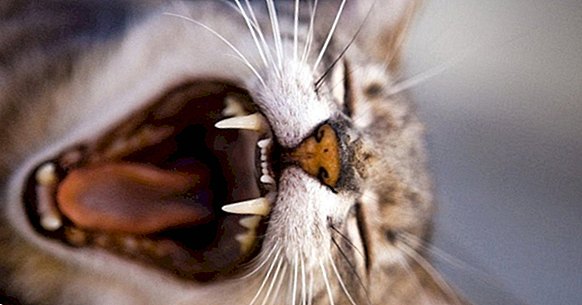Phobia to cats (ailurophobia): causes, symptoms and treatment
Cats are one of the favorite pets of humans; however, while some individuals love these little creatures, others feel an intense fear towards them .
It seems difficult to believe that there are people who feel terrified by the presence of these animals, especially considering that many scientific investigations have shown that these small cats provide many benefits for humans. For example, they help prevent allergies in children, improve self-esteem and mood or prevent respiratory infections. But nevertheless, the world of phobias is diverse and to a certain extent independent of rationality.
- Related article: "Types of phobias: exploring the disorders of fear"
Phobia for cats: what is it?
Although cats tend to have a reputation for being selfish and interested, especially when there is food involved, a scientific study has shown that they love humans more than we used to think (you can find out about this study by clicking here). But regardless of whether we like cats more or less, some people they experience an irrational fear of these animals , a fear that causes them great anxiety and that makes them try to avoid their presence at all costs.
This disorder it is known as aliurophobia or phobia of cats .
A phobia is an extreme, irrational and persistent fear towards an object in particular, activity or situation. It belongs to the group of anxiety disorders, in which exposure to the feared stimulus can cause different symptoms such as nervousness, anxiety, sweating, tremors, heart palpitations, shortness of breath, etc. The phobia towards cats is totally irrational, and even if a cat does not represent a real danger to these people, its mere presence can trigger this strong involuntary reaction.
What causes this phobia
Experts claim that phobias have different causes, although the most frequent is the occurrence of a traumatic event in the past .
For example, when a child is bitten by a cat, it can generalize and see all animals of this species as potential attackers, regardless of whether they are aggressive or tame. This occurs through a type of associative learning called classical conditioning , which was originally discovered by Ivan Pavlov and later popularized by John Watson.
Classical conditioning is also called learning stimulus response or E-R. If you want to delve into how this learning happens. You can read this article: "Classical conditioning and its most important experiments"
False beliefs can also cause this phobia , because cats are often associated with black magic, witchcraft, sadism and evil, especially black cats, thanks to Halloween legends, superstitions and countless literary works.
In addition, some researchers believe that the genetic origin it may or may not favor the appearance of phobias, that is, some people are more prone to suffer this type of fear than other people. Other experts believe that personality plays an important role in phobias, since people with anxious personality traits would be more likely to suffer this irrational fear.
What characteristics does this pathology have?
Phobias are far from the fear that a person can feel towards a cat that perhaps shows an aggressive attitude. And it is that normally cats do not usually threaten humans , but they feel very comfortable before their presence, especially domestic cats. Some of them, in fact, look for constant signs of affection when being surrounded by people.
For fear of cats to be considered a phobia, it must be irrational and not be associated with coherent thoughts, cause great discomfort in the presence of any cat, to be persistent, to be uncontrollable and, therefore, to provoke the avoidance of the phobic stimulus, in this case, the cats.
Symptoms of aliurophobia
The most frequent symptoms of ailurophobia in people are:
- Extreme and irrational fear (can also be caused by a thought or an image of a cat)
- Fight fight response in the presence of a cat, idea or thought of it, that is, try to avoid the situation that the person considers threatening.
- Also avoid the places where cats are or can find them. For example, not accepting the invitation to a friend's house because he has a feline.
- Great discomfort and anxiety in the presence of a cat, thought or idea.
- Realize that fear is irrational but can not control it.
- Hypervigilance and extreme nervousness thinking that he can meet a cat.
- Panic attacks with signs such as agitation, shortness of breath, sweating and wet hands, rapid pulse, etc.
- Dizziness, nausea and intestinal discomfort.
Treatment
The treatment of this phobia is not different from the other phobias and, since it is usually given by classical conditioning, cognitive behavioral therapy is usually one of the preferred treatments because of its great effectiveness.
Cognitive behavioral therapy (CBT) focuses on changing the thoughts and behavior of a person who is considered maladjusted and who is causing the discomfort. The therapist, in the beginning, usually helps the patient to understand why he has developed a phobia, and usually provide a series of tools so that it can overcome .
The idea is that the subject substitutes the negative and irrational thoughts that he has towards cats for more realistic and adaptive ones. The therapy sessions also help to release the stress and tension that one has been having due to the phobia.
Techniques used
Some of the techniques most used in cognitive behavioral therapy for the treatment of phobias are expository techniques and relaxation techniques. Therefore, the therapist guides the person through regular exposures that include the presence of the cats.
This is usually done gradually, and usually begins, for example, with pictures of cats, videos, stuffed animals and, finally, real cats. In addition, the goal of one of these exhibition techniques, called systematic desensitization , is to encourage more useful coping skills when the patient is exposed to phobic stimulation.
Psychotherapy sessions also teach different forms of relaxation including control of breathing and mental visualizations , and other therapeutic methods such as Mindfulness or Clinical Hypnosis can be used.
Medications, usually anxiolytics (although also antidepressants), can be used in more severe cases, those in which the patient has panic attacks.
New technologies applied to the treatment of phobias
The new technologies are also beginning to be used for the treatment of these pathologies, since they have turned out to be very useful. Virtual reality (VR) or augmented reality improves the patient's therapeutic experience .
Also, there are different "apps" for mobiles that can be used to treat phobias and are useful for this purpose.
- Related article: "8 apps to treat phobias and fears from your smartphone"



















